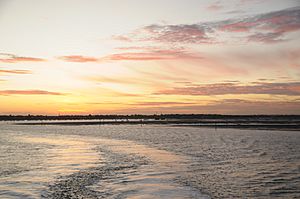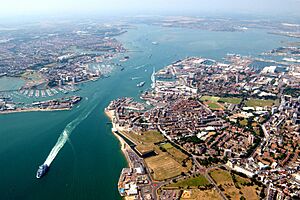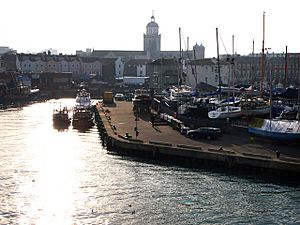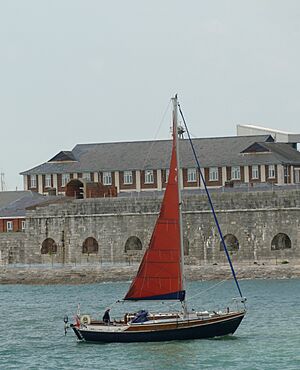Portsmouth Harbour facts for kids
| Site of Special Scientific Interest | |
 |
|
| Area of Search | Hampshire |
|---|---|
| Interest | Biological |
| Area | 1,264.2 hectares (3,124 acres) |
| Notification | 1992 |
| Location map | Magic Map |
Portsmouth Harbour is a very important natural harbour in Hampshire, England. It's a huge area, about 1,264.2-hectare (3,124-acre) of land and water. This special place is located between the cities of Portsmouth and Gosport. It's recognized as a Site of Special Scientific Interest because of its amazing wildlife.

Long ago, this harbour was a river valley that flowed from Portsdown into the Solent sea. At its northern end, you'll find Portchester Castle. This castle was built by the Romans to protect the harbour.
The harbour's entrance connects to the Solent. Portsmouth Harbour is most famous as the home of the Royal Navy at HMNB Portsmouth. Because of its great location on England's south coast, it has been a naval base since the Middle Ages. The Isle of Wight helps protect it naturally.
The narrow entrance and surrounding forts made it very hard for enemies to attack from the sea. Before these forts were built, the French actually burned Portsmouth in 1338. Later, during the English Civil War, a brave group of parliamentary forces managed to capture a ship called Henrietta Marie right inside the harbour!
Today, the harbour is also a busy place for commercial ferries. These ferries travel to places like Le Havre, Cherbourg, and Saint-Malo in France. They also go to the Channel Islands and the Isle of Wight. There's also a special passenger ferry that takes people to Gosport. Many people also enjoy sailing for fun in the harbour. In 2006, a new area called Gunwharf Quays opened, which includes the tall Spinnaker Tower.
Contents
Islands in the Harbour
Portsmouth Harbour has several islands.
- Whale Island is where the Royal Navy's training base, HMS Excellent, is located.
- Horsea Island used to be an island but is now connected to the mainland. It's also part of HMS Excellent.
- Pewit Island is a small island in the north-western part of the harbour.
- Closer to the harbour entrance, on the Gosport side, is Burrow Island, also known as Rat Island.
Camber Dock: A Historic Spot
Camber Dock is the oldest part of Portsmouth Harbour that was developed by people. It's in the historic area of Old Portsmouth. From 1590, people started building storage areas and other facilities here. In the 18th century, this area became popular with sailors visiting the port.
As ships got bigger and started using steam power, Camber Dock became too small. So, the main harbour was developed for larger ships. Because of this, Camber Quay became home to the local fishing fleet, and it still is today! You can also find a commercial fish market there. Today, boats that aren't for commercial use can also dock here. In 2015, the headquarters for the Land Rover BAR yacht racing team was built here.
Portsmouth Ferry Port
Portsmouth has a very busy ferry port.
How the Ferry Port Started
In the late 1960s, people looked at three different places for a new ferry port. The current location was chosen because it was affordable and good for cross-channel ferries. It was also at the end of the new M275 road. The port opened in 1976 with two berths (places for ships to dock). Ferries started sailing to the Channel Islands and to Cherbourg and Saint-Malo in France.
Growth of the Port
By the mid-1980s, more ferries were using the port, so it needed to grow. Two more berths were built. This allowed more ferry companies to use Portsmouth, and new routes opened to places like Caen, Santander, and Bilbao.
However, after the Channel Tunnel opened and duty-free shopping ended, many ferry companies stopped operating from Portsmouth.
Portsmouth Ferry Port Today
Today, Brittany Ferries is a main operator from Portsmouth. They offer services to Caen, St Malo, and Le Havre in France. They also have high-speed seasonal services to Cherbourg. Brittany Ferries also sails to Spain, with trips to Bilbao and Santander.
Condor Ferries has daily sailings to the Channel Islands. They use the Commodore Clipper for passengers and freight, and the Commodore Goodwill for freight only.
The port also welcomes many cruise ships. In 2018, 45 cruise ships visited Portsmouth!
In 2016, the harbour was made deeper (dredged) so that the Royal Navy's new, very large aircraft carriers, HMS Queen Elizabeth and HMS Prince of Wales, could arrive. Regular dredging keeps the harbour deep enough for these huge ships.

Wildlife in the Harbour
Most of Portsmouth Harbour is made up of mudflats and special grass called cordgrass marshes. These areas are full of tiny creatures that live in the mud. These creatures are a very important food source for birds. The harbour is especially important for dark-bellied Brent geese and three types of wading birds: grey plover, black-tailed godwit, and dunlin.
Ideas for a Tunnel
Over the years, there have been ideas for a tunnel crossing the mouth of the harbour between Gosport and Portsmouth.
- In 1941, during World War II, a tunnel was suggested to help people walk between the two towns and also act as an air raid shelter.
- Later, in 1999, a study looked into building a tunnel for a light rail system. This would help with traffic. An "immersed tube" tunnel was thought to be the best idea because it wouldn't close the harbour for too long. The tunnel would be about 1 kilometer long, with most of it underwater. This tunnel was meant to be part of a light rail network connecting Fareham, Gosport, and Portsmouth. However, due to money problems, the project was never built.




